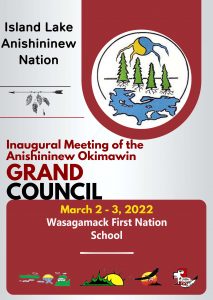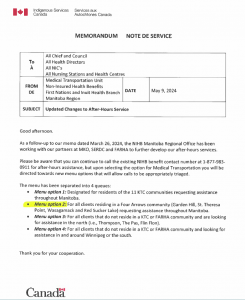Island Lake residents still waiting for so-called treaty benefits
By: Helen Fallding
Posted: 11/6/2010 1:00 AM |

Sam Wood takes a drink from Kalicahoolie Lake, north of Wasagamack. This is traditional hunting and fishing area for the First Nation.
ISLAND LAKE — “A hundred years of disappointment,” a banner might have read at last year’s centennial celebration of the treaty that brought the indigenous people of Island Lake into a “trust” relationship with the Canadian government.
That agreement to share their land in exchange for a settled life as farmers didn’t exactly pan out.
Neither did giving up their ceremonies for salvation from the white man’s God. In fact, conversion to Christianity created rifts that still divide this neglected corner of the province, making it hard for local people to lobby with a united voice for services they desperately need.
Island Lake’s residents were among the last indigenous people in Manitoba to obtain a treaty, largely because immigrants were not interested in settling their land or even building a railway across it. The region was the last to get high-amp electrical service, and residents are still waiting for a road and praying for running water.
It all started in 1909, when roaming hunters from the area agreed to settle into townsites, where the government promised to help them build a better life. The chief and two councillors who marked their Xs on the treaty with King Edward VII counted on a healthier future for their people, who were reported to be starving. Their only source of income — the fur trade — had dried up as fur-bearing animals grew scarce from overharvesting to satisfy European demand.
The treaty didn’t mention drinking water — why would it, in a land teeming with sparkling lakes?
“The Creator put us in the Canadian Shield,” said Victor Harper of Wasagamack, who is gathering his community’s history.
“The water was clean.”
What the treaty did promise was ammunition, twine for fish nets, $5 annually per person — about $100 in today’s dollars — and reserve lands, where the indigenous people were to settle as farmers, with tools supplied by the government.
“The government of Canada told our people to find a place in Island Lake where there is lots of grass — estuaries that had grass — because the government wanted to give us cows, livestock,” Harper said.
When a surveyor arrived in 1913, the Island Lake people chose reserves along the water’s edge, where every family had easy access to unpolluted drinking water. Even the dreaded waterborne beaver fever (Giardia) parasite — that still plagues wilderness hikers with explosive diarrhea — had probably not yet reached this isolated part of the world.
Island Lake residents remember well how their ancestors lived out on the land, because many of them follow the same familiar routines when they head out to hunt or fish. They cup their hands in rivers and lakes to drink or camp where springs bubble up from the ground. In winter, they melt snow for drinking water.
In the old days, families used to set aside a spot for an open-air toilet at each campsite and use moss or sticks for toilet paper, elder Saul Harper recalls. With small family groups moving in tune with fresh game and the seasons, they didn’t stay long enough to foul the environment.

Former Red Sucker Lake chief Fred Harper shows a water project that failed when the line froze.
Descendants of the treaty’s signers eventually divided into four villages, three around scenic Island Lake and another at nearby Red Sucker Lake, as they followed Roman Catholic and Protestant missionaries fighting over their souls.
“The priest… did every subtle thing he could to turn the Indians against me and our mission,” Rev. Roscoe Tranmer Chapin complained in his memoirs. He moved the Protestant mission to Garden Hill in 1925, taking followers of “the true gospel” with him, while the Catholics claimed St. Theresa Point across the lake.
Protestant missionaries were easier for indigenous people to get used to because they were more like Hudson’s Bay Co. men, historian John Webster Grant wrote. But he said the Roman Catholics had an edge because they lived closer to indigenous people and their robes and rituals loaned them authority.
In Island Lake, the French-speaking Roman Catholics won some people over by bringing in a portable sawmill to make free lumber. Some residents who had lived in communities in Ontario where the Oji-Cree language is also spoken before migrating to Island Lake in the early 20th century had already had enough of Catholic preaching there, according to Chapin’s version of events.
The treaty’s promise to turn the “smooth rock people” into farmers turned out to be absurd, situated as they were on thin pockets of soil over glacier-scraped bedrock with a short growing season. For decades after the treaty was signed, many families continued to spend winters hunting at bush camps, returning to their reserves only in summer.
On the reserves, they built log homes spread far along the shore, with each clan responsible for litter and latrine pits covered with logs, according to Harper, 58. Some stayed in these settlements all year, but many came and went as they continued their semi-nomadic life of hunting moose, netting fish and picking berries.
“We lived well,” Harper remembers of his healthy and loving family life before he was scooped up and sent to residential school.
In the 1960s, fur prices crashed, forcing more people into the settlements and greater dependence on the government.
That’s when Indian Affairs decided to replace the old log homes with new houses side-by-side, Harper recalls.
“Manitoba Hydro was going to give us electricity,” he said, showing how his father demonstrated the magic of artificial light to family members who had never seen it.
“‘If you want light, pretty soon all you gotta do is click’,” Harper remembers the chief saying in Oji-Cree, flicking his finger on an imaginary switch.
“You’ll hear a clicking sound and — voila — the light will come on.”
Basic electricity came to Island Lake in 1967, but there was no sanitary plan as the population density increased. Residents dug pits for garbage and sewage, but as the shallow pits filled up, they had to search for other spots in the rocky ground.

UNITED CHURCH OF CANADA ARCHIVES
A group of Island Lake Oji-Cree at their winter camp in the 1920s.
Leaking pits soon made the lake water along the shore unfit for drinking.
“I remember people getting sick because of the garbage,” Harper said. “All the outhouses have already taken just about all the ground — there’s no place to build an outhouse now.”
VIctor’s father Zaccheus Harper was the last chief responsible for the four reserves spread out around Island Lake and Red Sucker Lake. In 1969, the 2,800 or so indigenous people split into four First Nations, each with its own chief.
Victor blames that political division on the wedge driven when Island Lake people split into different town sites 40 years earlier over religious differences. He also blames the Canadian government that encouraged the missionaries to “civilize” indigenous people.
“The churches were devised by the government to make sure you divide these whole Island Lake people. ‘Let them fight with each other,'” Victor Harper said.
If the four Island Lake First Nations had remained united, they would be the fourth most populous First Nation in Canada, after Ontario’s well-known Six Nations and Akwesasne Mohawks, and the Blood of Alberta. It’s hard to imagine those powerful groups still having to fight for basic services such as running water.
“I’ve often said that if we had stayed together, we’d have more political clout,” said former Garden Hill chief Darcy Wood.
Most First Nations in Manitoba and the rest of Canada have running water, even those far more remote than Island Lake, such as Northlands First Nation way up near the Nunavut border.
There were some failed attempts to catch up in Island Lake.
When revered national aboriginal leader Elijah Harper was Red Sucker Lake chief in the late 1970s, the community built a water line wrapped in electrified heat tape — a common practice — but when the diesel-powered electricity generating plant quit for a few days, the line froze and split.
“You don’t know where the breakage is, so basically the whole water line was destroyed,” Harper said.
Even if more pipes could have been installed, the region’s electrical service wasn’t powerful enough to run water and sewage treatment plants big enough to serve thousands of residents.
Island Lake was the last region of Manitoba to be hooked up to electricity transmission lines, which didn’t happen until 1999. Some far northern Manitoba First Nations still rely on diesel electricity generators, but they were upgraded to higher-amp service in the early 1990s, before Island Lake.
Island Lake First Nations have been competing for the attention of Indian Affairs, which funds water and sewer upgrades in each community “based on priority and the availability of funds,” according to department staff.
Garden Hill made real progress a couple of years ago when homes in the south and central areas of town were hooked up to water and sewer pipes at a cost of $25 million, and Red Sucker Lake is getting a new $6-million water treatment plant this year. St. Theresa Point expects to get funding for expanding water services in the next few years, then Wasagamack has a $5.5-million water and sewer project tentatively scheduled for 2014-15. Only then will it be Garden Hill’s turn again.
The four bands are trying to overcome historical divisions and work together through the Island Lake Tribal Council, which employs technical staff who give advice on projects such as water and sewer services.
SInce 1999, INAC has spent more than $75 million on Island Lake treatment plants and piped distribution, plus water and sewage trucks to service homes with storage tanks because they are farther from the treatment plants.
But bringing supplies to Island Lake is slower than in southern communities accessible by all-season roads and slower than in the Far North, where the winter road season lasts a few weeks longer because of colder temperatures and permafrost.
In communities that rely on ice roads, fresh food is flown in, but everything else needed for the entire year, especially bulky construction supplies, must be trucked up during the window when winter roads are open.
Island Lake’s winter roads were usable for less than four weeks this year, compared to the once-standard 10 weeks. In Wasagamack, the water treatment plant had to be temporarily shut down in March because the community ran out of chemicals. Indian Affairs was forced to charter flights for emergency supplies at huge expense. The situation will only get worse as the global climate heats up.
A permanent road is in the works, likely to connect Island Lake to Norway House or Cross Lake at the top of Lake Winnipeg, but it will take about 15 years to build.
“You can’t wait that long,” to get running water for the rest of the homes, Manitoba Grand Chief Ron Evans said.
“Water is a basic human right.”
Former Red Sucker Lake chief Fred Harper has been saying the same thing for two decades.
“The people of Island Lake have been really patient,” said the man who now serves at the community’s health director.
“(Governments) should realize it’s an emergency.”
helen.fallding@freepress.mb.ca



